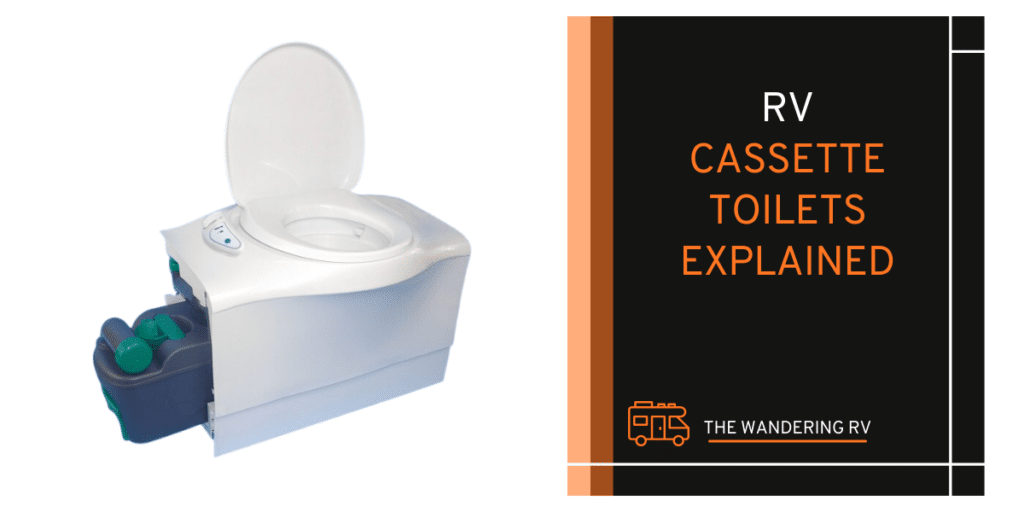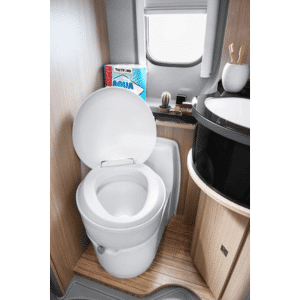
If you’ve ever wondered what it would be like to boldly go where no RV enthusiast has gone before, look no further than the world of cassette toilets! These compact and convenient contraptions are revolutionizing the way we “do our business” on the road, but do they truly flush away the competition? In this article, we’ll explore the ins and outs of cassette toilets, weighing the pros and cons, diving into the art of waste disposal, and pitting them against their portable counterparts in the ultimate bathroom showdown. So, grab your plungers, and let’s plunge into the captivating realm of cassette toilets!
Table of Contents:
What is a Cassette Toilet?
There’s not a lot to them, to be honest. Cassette toilets are essentially a fixed feature in your RV, much like a standard RV toilet. However, instead of flushing waste into a sizable built-in black water tank, they channel it into a more compact and easily removable black water container.
These are popular in smaller RVs, like a Class-B or camper van, or small travel trailer campers. Instead of having 30+ gallons of black water storage, most cassette tanks are closer to 5 gallons.
And How Does a Cassette Toilet Work?
It functions just like a traditional RV toilet would. You do your business and flush it down. Unlike portable toilets, they are securely fixed in your bathroom.
The difference is that with your cassette toilet is when the black water tank is full, you physically remove the small black water tank from your camper and carry (or roll, if it has wheels) it somewhere to dump it. They are made to be easy to transport and dump. Instead of needing to be emptied into a dump station, you can also empty it into a regular toilet. It is basically the exact same as any RV toilet, but it has a much smaller, portable black water tank.
What are the Benefits of a Cassette Toilet?
The biggest advantage is the compact size of the black water tank. Instead of finding room for a permanent 20+ gallon black water tank, these toilets just need a small compartment under the toilet to slide into. The next advantage is that you can empty them into any toilet. Since it only holds ~5 gallons, you can slowly empty the tank into a public toilet, flushing as needed. They are also extremely easy to rinse and keep clean. Since you will be emptying the toilet more often, it will keep the odors down and will tend to stay cleaner.
How Often Do I Need to Empty My Cassette Toilet?
This obviously depends, but most people report needing to empty their cassette waste tanks every 2-3 days. Since they only hold 5 gallons, it will tend to fill up much quicker than the normal 20+ gallon black water tank. As a full 5-gallon waste tank may weigh up to 50 lbs, you may want to empty it more often to make it easier to transport and empty!
How to Empty Your Cassette Toilet
Since there are no sensors to show you how full your cassette toilet is, you’ll have to take a quick peek to determine the level. It’s best to do this daily, as you DEFINITELY don’t want to overfill them! Once you are ready to empty your cassette toilet you’ll need to take the following steps:
- Clear out your toilet bowl. Turn off the water and flush the toilet to get any remaining water out of the bowl into your tank.
- Close the valve to your black water tank.
- Open up your access panel to the holding tank. Depending on your setup, this could be inside, under your toilet, or accessed from an exterior storage compartment.
- Remove the portable black water tank.
- Carry the tank (or roll if it has casters) to a dump location. The easiest would still be a dump station, but as we mentioned, you can definitely use a regular toilet.
- Open up the dump spout and carefully dump the contents.
We recommend all of the safety gloves for this! Most portable tanks have a swiveling spout to make this easier. They also have a pressure valve to allow the contents to flow out better. Just be sure to have your spout pointed in the right direction before opening.
Clean and rinse your tank. Place your tank on level ground and fill it ⅓ with water. Close up all of the spouts and swish the water around. Rinse and repeat a few times until the water coming out is clear. We also recommend using this handy pine-sol recipe to help! Then put a little bit of water, and a bit of your pine-sol recipe, and place the tank back in your camper. Hook everything back up in reverse order, and you’re set!
Cassette Toilet Tips and Tricks
Most people avoid using cassette toilets for #2. This makes emptying the tanks, keeping odors down, and keeping them clean much easier.
Keep the toilet lid closed. To avoid any “splash back” keep the toilet lid closed while flushing.
Avoid flushing toilet paper. This will help make emptying the tank an easy process. Toilet paper may clog up, or get stuck on the interior walls of your tank. Keep a dedicated waste bin with a lid to throw away your TP.
Empty it on a regular schedule. Most people empty their cassette toilet every 2-3 days. It is critical to do this whether the container is full or not. This is to keep it smelling fresh and working properly.
What are the Best Cassette Toilets?
I’m glad you asked! Here are our top two cassette toilets:

Thetford C223CS RV Cassette Toilet
This cassette toilet includes the toilet set, base, and waste tank. It holds 4.75 gallons and includes a waste tank level indicator. The base is permanent and the seat swivels 180 degrees which is great for tight spaces!


Thetford C402C RV Cassette Toilet
This one is great for a DIY install. It incorporates its own bench, water tank, and waste cassette. All you have to do is build the enclosure, wire it for power, and create an access hatch on the side of the van for access to the cassette. It includes a tank for both flush water of 4 gallons and a waste holding tank of 5.1 gallons.
A common complaint is that it is small and a bit flimsy though!
Another way to extend the tank size of your cassette toilet is to buy a portable holding tank. If you have the room for it, adding 20-30 gallons of waste capacity is a game changer!
We recommend this 28 gallon version from Camco.
Conclusion
In conclusion, cassette toilets offer a unique and convenient solution for managing waste in the ever-evolving world of RV travel. With their compact design, user-friendly waste disposal process, and a range of pros and cons to consider, they’ve carved out a niche in the RV sanitation market. As you weigh your options, it’s crucial to understand how cassette toilets compare to portable toilets and traditional RV toilet systems to determine which best suits your needs and preferences. Ultimately, the choice is yours, but with the information provided in this article, you’re now well-equipped to make an informed decision and keep your RV adventures rolling smoothly down the road.




